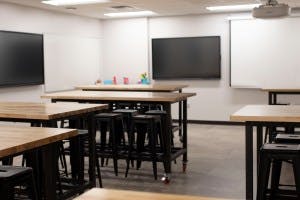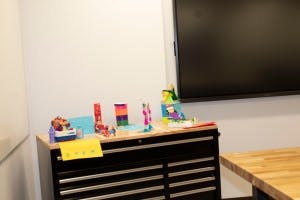This fall marks the first time faculty are teaching in Aderhold Hall Room 607 after it was renovated into a multipurpose classroom featuring new digital whiteboard technology and easy-to-move tables and chairs for small group breakout sessions.
In line with other classroom renovations in the College, this space provides students with a collaborative, active-learning environment, as well as the resources for faculty to engage their students on a more creative and dynamic level.
“We’re designing these rooms in ways that give instructors and faculty much more flexibility to support a wide range of pedagogical decisions and student interaction.” said Nic Holt, director of innovation in teaching and technology in the College of Education. “So, if there’s a departmental preference, we’re listening, and a lot of this is learning how our faculty want to work, showing them new things and letting them be part of that design process.”

The renovated area—which previously contained an office space and a smaller classroom—now serves as a flexible teaching environment for faculty in the Mary Frances Early College of Education, as well as faculty across UGA’s campus.
With seating for up to 80 students, the classroom is the College’s largest and is particularly suited for faculty and students in art and music education.
The custom tables, which were built by UGA’s Sheet Metal Shop using recycled metal components, can be moved around or connected to other tables to create large tabletop spaces for students to work on art projects. These tables can also be pushed to the side for dance and other movement-based lessons.
“This set-up also allows for a stand-up workspace for other projects,” said Ralph Knapp, director of the College’s Office of Information Technology. “These tables were built to our design, and they’re special because many of the metal posts that they’re made out of came out of the old Aderhold G5 classroom.”
Other features of the classroom include eight interactive whiteboards that are connected to the internet, which faculty and students can use for a variety of innovative purposes, including painting and drawing in a more sustainable manner.
While the room was designed with active-learning in mind, faculty can also use it for traditional lectures or research purposes.
“We’re definitely trying to accommodate and encourage a pedagogically diverse faculty, in terms of their teaching style and the sorts of activities they’re engaging in with their students,” added Holt. “And we’re also pushing them a little bit towards tomorrow. Our college can take a lot of pride in our state-of-the-art learning environments we’ve created so far. As UGA continues to encourage more instructors to employ active and experiential learning strategies, our college is positioned. Active learning is not something that the University needs to push us to do—we’ve been doing that for 20 years.”

This past summer, the College also completed a classroom renovation in River’s Crossing and plans to renovate six more classrooms in Aderhold Hall this fall.
Faculty interested in learning more about incorporating interactive technology into their teaching are invited to attend the College’s Innovation in Teaching and Technology Academies offered in the fall and spring semesters. Led by Holt, the academy provides thematic professional development opportunities for instructors interested in employing new technologies with active learning strategies.
“I think there is still some confusion about what active learning is and a belief that active learning is technology centric or something like that,” said Holt. “But it’s really about a pedagogic strategy and the sorts of instructional approaches that get learners actively and deeply involved in the content. We’re looking for the tools that can best accommodate these approaches. They need to be easy and quick to use and shouldn’t require a long time to learn or set up. Most of all, they need to work every time. And to that end, I think the best technologies are the ones that become invisible to the learning process.”
